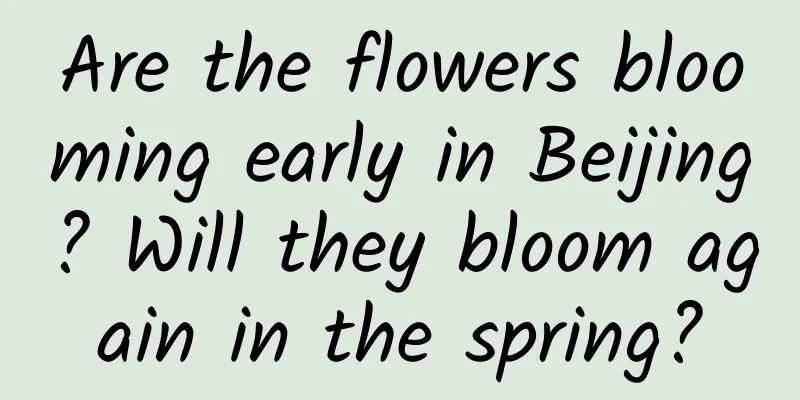Are the flowers blooming early in Beijing? Will they bloom again in the spring?

|
Audit expert: Yang Yanhui Senior Landscape Engineer, Beijing Haidian Water Ecological Construction Development Co., Ltd. During this period in Beijing’s parks, you may be surprised to find that some flowers that were usually only seen in spring are blooming now. Image source: Qianku.com In the National Botanical Garden, the wintersweet "Jiuyingmei" that should have bloomed around New Year's Day in previous years has bloomed about a month earlier. In addition to wintersweet, other spring flowers such as mountain peach and winter jasmine also opened their buds in this slightly warm early winter, a phenomenon that attracted a large number of tourists to check in and take photos. Why does it bloom out of season? According to research, the flowering time and phenological period of plants are affected by climate, environment and cultivation conditions, and one of the main influencing factors is temperature. When temperatures rise suddenly in each season, plants may mistakenly think that spring has arrived. Plenty of sunlight and warmth help break the dormant period of flower buds and encourage them to sprout. Image source: Qianku.com The germination of flower buds generally goes through the processes of bud swelling, scale cracking, bud blooming and opening. The germination of flower buds requires certain temperature conditions. Generally speaking, high temperature will accelerate the germination process of flower buds. According to the National Climate Center, the average temperature across the country this autumn (September 1 to November 30) was 11.8°C, 1.5°C higher than the same period in previous years, the highest in the same period since complete meteorological observation records began in 1961. It is expected that in winter (December 2024 to February 2025), the temperature in most parts of the country will be close to or higher than the same period in previous years. Some time ago, the temperature in North China continued to rise after a cold wave, which may be one of the reasons affecting the early blooming of spring flowers. Chen Hongyan, deputy director of the Science Museum of the National Botanical Garden (North Garden), once said, "Rising temperatures will affect plant growth." Chen Hongyan said that plants need a certain amount of accumulated temperature to complete their life cycle, that is, plants require a certain amount of daily average temperature accumulation from sowing to maturity. When the effective accumulated temperature reaches the requirement for flowering, the plants will have an illusion that spring has arrived, so they bloom early. "The rise in temperature has a great impact on the entire growth cycle of plants. For plants, the most direct feeling is 'Spring is here, I can bloom', which is a temperature signal. Plants feel such climate change, and their flowering period is greatly advanced." In addition, flowering of plants is also regulated by genetic and physiological mechanisms. In order to protect themselves under drought conditions, plants may bloom early. Proper pruning and fertilization may also promote plants to bloom out of season. Now that it’s blooming, can it bloom again in the spring? Generally speaking, flower buds that open prematurely will not continue to open in the same position in the spring of the following year. However, the amount of flowers that bloom out of season is generally not large and the duration is short. Most of the flowers will bloom normally in the spring of the following year and will not affect the normal growth of the plants. Does light also affect plants' perception of seasons? How do plants know when to bloom, bear fruit, and shed leaves? This is mainly because plants have proteins that can sense temperature, light, and night time. Plants are stimulated to flower by changing from short-day to long-day, which affects the growth hormone of the plant. In terms of light perception, plants have established a complete system with proteins such as phytochromes and cryptochromes as the core. Phytochrome proteins can undergo reversible changes under red light/far-red light, thereby regulating the downstream signal network to control plant life. Image source: Qianku.com The earth's revolution causes the ratio of day and night to change periodically throughout the year in most areas. Plants can sense changes in light and light duration. When the light hours are short and the dark hours are long, and they last for a period of time, corresponding to spring and autumn, short-day plants will be induced to bloom; and when the light hours are long and the dark hours are short, and they also last for a period of time, corresponding to summer, long-day plants will be induced to bloom. Short-day plants refer to plants that can only bloom when the length of daylight is shorter than their critical day length. Common ones include cocklebur, morning glory, chrysanthemum, etc.; crops include rice, soybeans, corn, tobacco, hemp and cotton, etc. These plants usually bloom in early spring or late autumn. Long-day plants refer to plants that need a period of time during their growth and development. If the number of hours of sunlight per day exceeds a certain limit (more than 14 hours), flower buds will form faster. The longer the light time, the earlier the flowering. Most spring flowers are long-day plants. There are so many mysteries behind the quiet closing or passionate opening of a flower. This is the language of dialogue between plants and the environment, and also the endless movement of life science. |
<<: What! Soba noodles are unhealthy? The truth is...
Recommend
Which self-media platform is the best? 2018 self-media platform recommendation
In the past 2017, the self-media industry has ach...
Analysis of AARRR models of Starbucks, luckin coffee, Pinduoduo, etc.!
In the user operation system, there is a classic ...
Does frequent earwax cleaning help ear canal health? Don’t do it!
gossip "Recently cleaning earwax can keep th...
A man drank "fake wine" by mistake and became poisoned and critically ill. The doctor actually used "real wine" to save his life?
Everyone has heard of this Have you ever heard of...
Can the Centennial Orchid live 100 years? Wrong, it can actually live 2,000 years!
In 1859, Austrian botanist Frederich Welwitsch di...
Learn how to set up SEM search bidding flash in 10 minutes
When I first entered the industry, I was in a hur...
In the sports copyright market, which is fought for with real money, the losers have already lost and the winners have not yet won.
Two years ago, Zhao Jun, general manager of Ti Ao...
Can Valve's pre-sale of handheld consoles be a catalyst for Steam's development?
Players who are familiar with PC games are also f...
A day “tethered” by short videos
With the rapid development of short videos, the u...
Alibaba Mini Program Agency, how much does it cost to be an agent for a pregnancy and childbirth mini program?
There are two types of Ali pregnancy and childbir...
The more you eat, the whiter your skin becomes?! The truth is...
Whitening - an eternal topic in the skin care ind...
There are traitors among us! The nervous system is not only a victim of cancer, but also a guide
The nervous system affects almost all tissues of ...
Xunlei is sued in the US: Is it because of its inability to tell stories?
The hot summer of June 2015 is about to pass, and ...
WeChat lifts 5,000 friends limit, but users can no longer view Moments
Since WeChat became a work app, the number of fri...
These 7 steps helped me reach 1 million users in 6 months
Achieve 100,000 users in 6 months I had just arri...









